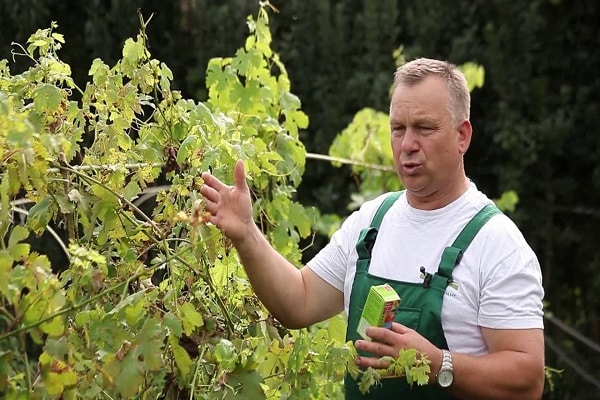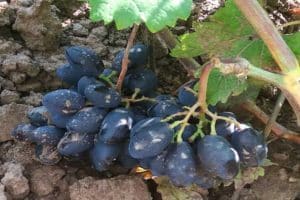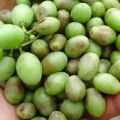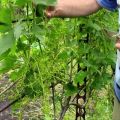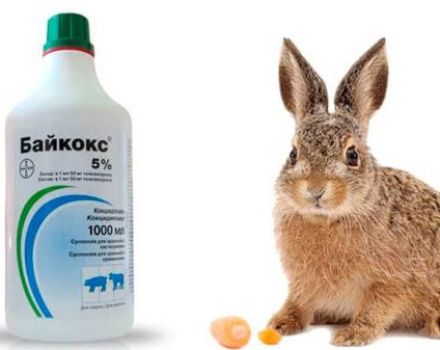How to deal with powdery mildew (powdery mildew) on grapes with folk and chemical means, the better to process
Almost every year, gardeners encounter powdery mildew on grapes, due to which its yield deteriorates at times. This disease is considered one of the most common pathologies that appear on vines. To save the plant, you should familiarize yourself with the description of the disease and the methods of its elimination in advance.
Description of the disease
Fungal-type infectious diseases often affect grape fruits. Because of this, they cannot be further processed and consumed fresh. Among the common infections, powdery mildew or powdery mildew should be distinguished.

Plants become infected with oidium disease after exposure to pathogens that live in the vine. In the spring, when the air temperature warms up to 15-20 degrees, the fungus begins to actively develop and infect the nearest vineyards. Most often, bushes become infected in the second half of spring or early summer with high humidity. However, with daily rains, the moisture level reaches too high levels, which leads to a slowdown in the development of the disease.
It is difficult to determine the presence of oidium at the initial stage of its development, since it practically does not manifest itself in any way. Only after 5-6 days you can notice the first symptoms of pathology. First, it affects the lower leaves of the grape bushes and gradually spreads to the upper leaves and fruit clusters.
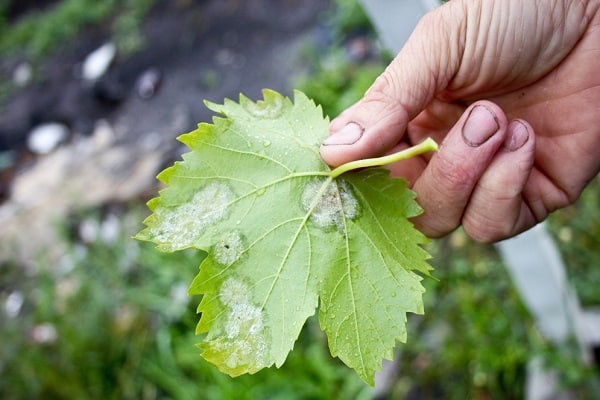
Causes of occurrence
It is recommended that you investigate the main causes of powdery mildew infection in advance. This will help you understand why grape bushes can become infected with such a dangerous disease.
The causative agents of powdery mildew are quite often found in the upper layers of the soil. However, optimal conditions are needed for their development. For example, if it is sunny, warm weather outside, and a person observes all agrotechnical rules for growing, then the fungus will not develop.
There are a number of conditions that contribute to the infection of the vines and the further development of the disease. These include:
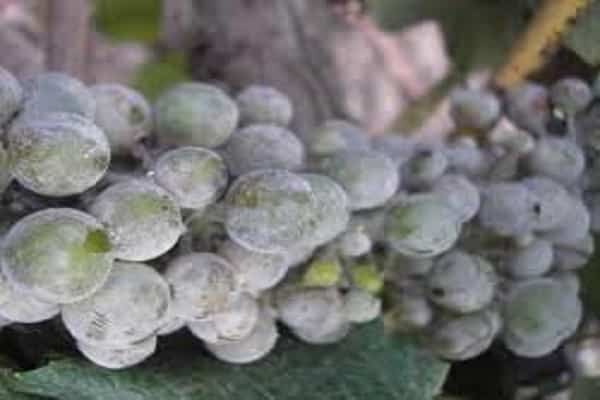
- Regular cloudy weather with high humidity. Lack of sunlight and high humidity levels are very dangerous for grapes. It is under such conditions that the causative agents of most fungal infections are activated.
- Increased nitrogen levels in the soil. Some summer residents, when growing grape bushes, add too much nitrogen fertilization to the soil, which contributes to the development of powdery mildew.
- Dense plantations. Bushes that are planted too close to each other are susceptible to powdery mildew infections.
- Improper watering.Sometimes the plants are watered very often, which is why the soil does not have time to dry completely. This significantly impairs the protective functions of the grapes, which leads to infection with fungal diseases.
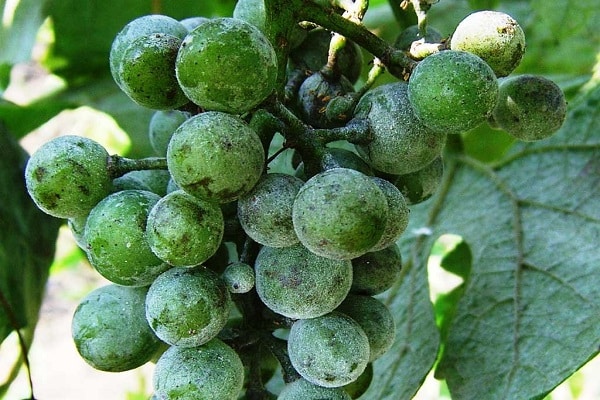
Signs of infection
In order to timely identify oidium on a plant, you should familiarize yourself with the main signs of pathology. There are a number of symptoms that appear only with such a disease.
The first signs of powdery mildew disease appear in the form of small white specks that appear on the surface of the lower leaves. After 1-2 days, the size of the spot increases, due to which the leaves are completely covered with white bloom. With the further development of the pathology, the spots progress, thicken and almost completely cover the grape seedlings. Because of this, when viewed from outside, infected plants seem to be completely covered with cobwebs or sprayed with a lime fluid.
However, in fact, the surface of the leaves, fruits and stems is covered with fungal epithelium, which consists of many conidia.
If the grapes are not cured in time, its leaves will begin to become covered with yellow spots and dry out. Also, due to the disease, the growth of bushes slows down and their immune system weakens. Because of this, grapes cope much worse with temperature changes and even minor frosts.
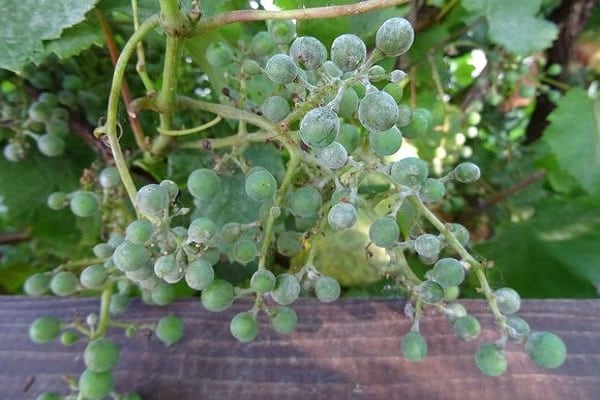
How to deal with powdery mildew on grapes?
It is necessary to deal with the disease when its first symptoms appear. This will stop the further development of the pathology and prevent the grapes from dying.
Any control measures are aimed at the complete destruction of pathogens of fungal infection. There are various methods of dealing with powdery mildew that will help heal the bushes. To increase the effectiveness of each of them, you will have to deal with complex treatment. However, before that, you will have to familiarize yourself with the main ways to combat a fungal disease:
- Sulfur solution. Experts advise to start treating powdery mildew using a liquid from sulfur. The procedure is best done in the morning or evening, when there is no bright sunlight. When spraying the liquid, make sure that it gets on all affected areas of the grapes.
- Colloidal sulfur solution. Treatment with such a remedy is considered quite effective, since it helps to quickly get rid of fungi on the bushes. Experienced gardeners recommend spraying once a week.
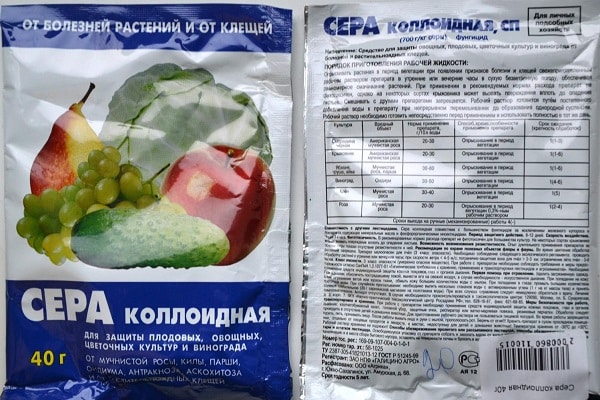
Effective chemicals
There are several effective chemicals that can help cure infected grapes. However, before using the drug to combat powdery mildew, you will have to familiarize yourself in more detail with each of them:
- "Topaz". Among gardeners and amateurs of growing grape bushes, Topaz is popular. The drug effectively fights many fungal infections, and powdery mildew is no exception. To get rid of the symptoms of pathology and save the plant, you will have to spray at least three times a month.
- "Vitaros". For the prevention and elimination of the symptoms of powdery mildew, you can use "Vitaros". This fungicidal preparation should be used in early spring when pathogens are just starting to become active.
- "Speed". To quickly eliminate the symptoms of infection, you should use the solution from "Skor". When preparing it, a glass of the drug is stirred with 10-12 liters of water. Plants are processed at least twice a month.
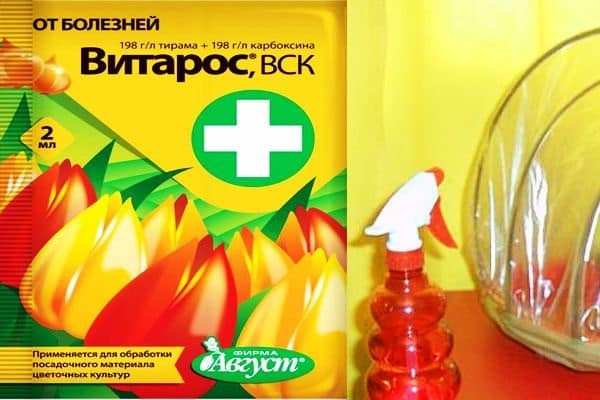
Folk recipes
Also, folk remedies are used to eliminate oidium. The most effective are the following:
- Serum. Lovers of folk remedies often use milk whey, which can relieve grapes from infectious diseases.Such a solution is not only able to eliminate the signs of the disease, but also to improve the functioning of the immune system. To create a solution with your own hands, you will have to stir part of the serum with two parts of heated water. The resulting mixture is treated every two weeks for three months.
- Iodine. A solution prepared from medical iodine also effectively fights powdery mildew. When creating a mixture for spraying, 10 ml of iodine is added to a container with ten liters of water and mixed thoroughly. Then, with the help of a spray bottle, grape clusters and leaves, which are covered with a white bloom, are sprayed with liquid. The procedure is performed twice a week.
- Ash. The ash remedy is able to prevent the death of plants infected with powdery mildew. To prepare a medicinal liquid, a kilogram of sifted ash is mixed in 7-8 liters of water and infused for 20-30 minutes. After that, 200 grams of soap is added to the solution. The infected grapes are sprayed with the solution three times a month.

Prevention measures
When growing grapes, they must be engaged in the prevention of diseases, since by taking preventive measures in time, you can save plants from death. Experienced gardeners consider proper care of the grown plant the best prevention. Observing all agrotechnical rules of cultivation, the likelihood of becoming infected with powdery mildew is minimized.
To prevent the grape bushes from getting sick, you will have to properly water them. Moistening the soil should be done no more than twice a week. In this case, the bushes should not be heavily flooded, since this will increase the moisture content of the soil and air. With prolonged droughts, watering is more frequent, since the soil dries out faster under such conditions.
Also, grapes need regular feeding, which will increase its protective functions. In summer, the soil is fed with potash fertilizers at least three times.
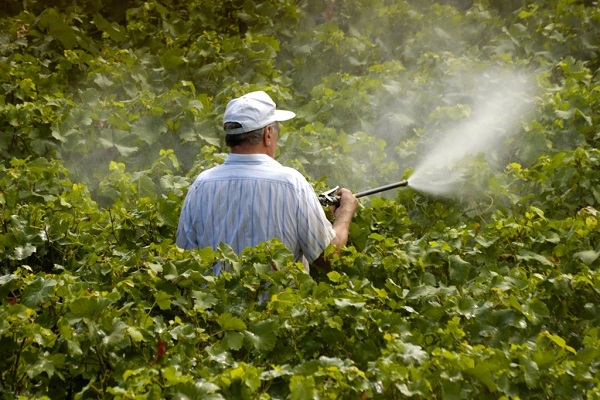
The most resistant varieties
Some gardeners are involved in the cultivation of powdery grape varieties. These include:
- Aligote. This variety is popular among winemakers as it belongs to the wine grape varieties. It is grown outdoors only in the southern or central regions. In cold climates, it is best to grow in greenhouses for higher yields. The advantages of Aligote include not only its resistance to powdery mildew, but also the taste of the crop.
- Sauvignon. A common variety grown by many to make aromatic white wine. The distinctive features of Sauvignon include small grape clusters with small berries, as well as resistance to many common diseases.
- Savraska. A well-known Altai variety with early harvest ripening. It is distinguished by huge tassels, the length of which reaches 35 cm, and delicious berries.
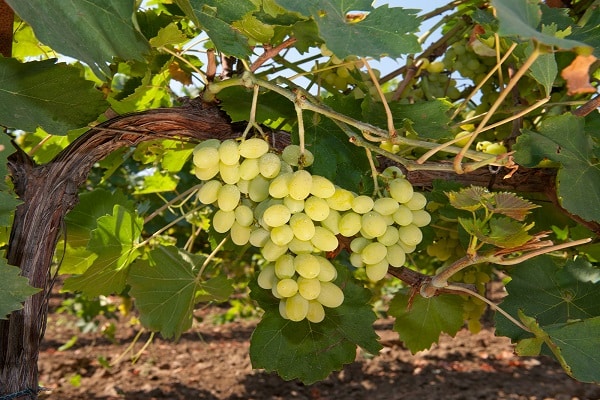
Conclusion
Powdery mildew is a common disease that affects many grape varieties. To get rid of it and protect the planted grape bushes, you will have to familiarize yourself with the main methods of dealing with powdery mildew and preventive measures.
